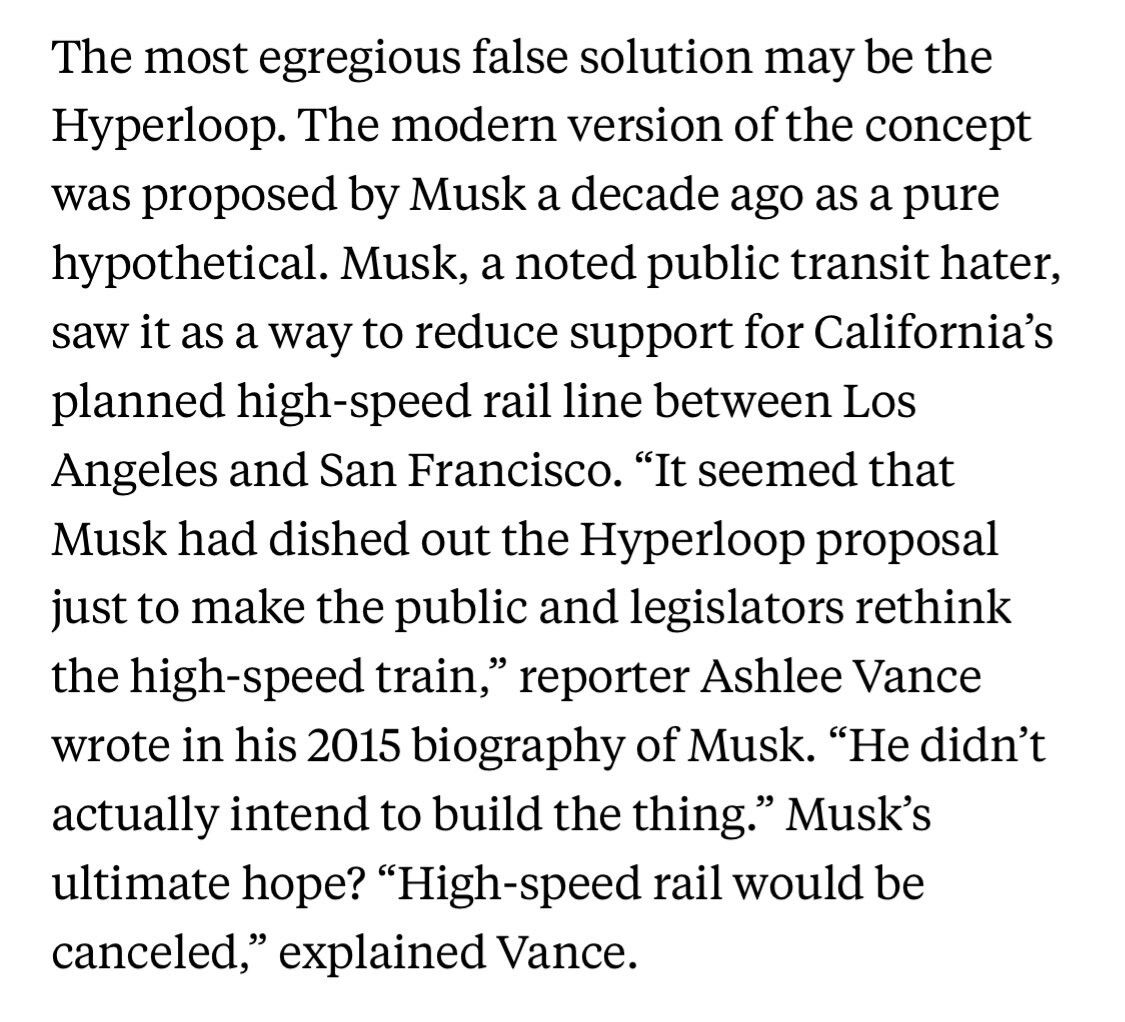- cross-posted to:
- politics@lemmy.world
- fuckcars@lemmy.world
- cross-posted to:
- politics@lemmy.world
- fuckcars@lemmy.world
The quote doesn’t show him admitting it, but rather says his biographer said it.
Thunderf00t made many videos about the Hyperloop and while you do need to keep thinking for yourself while watching them because he makes mistakes or interjects conjecture or personal opinion as fact at times, he still does a good job of showing how absurd Hyperloop is on its face.
The so-called “fall of Elon Musk” should be a reminder to everyone so just think for yourselves. I know the TV ended up painting this guy is the second coming of Christ, but you don’t become a multi multibillionaire several times over by just being a good guy. There’s an old saying, you can become a millionaire through honesty, integrity, and hard work, but you can’t become a billionaire.
Also everyone needs to keep in mind that most of his billions came out of your pocket. His companies are based off of massive government subsidies including the hyperloop, and one of the reasons why Tesla’s stock price is so high is just because of government policies that have led to a massive stock market bubble at the expense of the common man. And there’s just so much money sloshing around due to excessive government debt and massive central bank money printing it had to go somewhere, and it ended up going into stocks and other assets making those people rich while inflation adjusted wages have stagnated for decades.
I like Adam Something’s takes on it, which is essentially that the Hyperloop is dangerous and metros/subways are better.
Hyperloop and Loop are not the same thing. Loop is Teslas in small cheap tunnels. Hyperloop is high speed trains in vacuum tubes.
A vacuum under atmosphere is effectively a bomb. The loop is basically a fire tunnel waiting to happen. They are both stupid and dangerous.
I don’t know if I would call it a bomb. Like it could implode, but how much would that affect stuff outside the tube. Its a bad idea regardless, just doesn’t really seem like a bomb.
Woth how big it would have to be the sound waves alone would probably have semi-explosive like propeeties.
High quality comment! Thank you!
Adam Something has done a bunch of good quality videos on Elon Musk’s failed projects, including the Hyperloop.
His companies are based off of massive government subsidies including the hyperloop,
I’d love to know if he redirected any of that Government funding away from the hyperloop, to his other corporate interests.
Alternatively, the fall of Elon Musk was his way of getting Jack Ma’d, because money is not everything, and you can’t just buy yourself a tool of strategic value and expect no consequences.
Regarding your last paragraph:
Do you disagree with EV subsidies? The only reason Tesla was getting so many is because other components haven’t really made EVs till recently. I think EV credits are a good thing for society because of the lower environmental cost than gasoline vehicles.
You referring to SpaceX? they do make a lot of their money from the government, but almost all as a customer rather than an investor. They sell NASA a product for less than NASA could have bought it for otherwise. I don’t think that’s unfair at all.
I think EV credits are a good thing for society because of the lower environmental cost than gasoline vehicles.
I would think so too if the second part was true. While the emission cost of an EV indeed about 30% lower (data for Germany, probably worse in the US), that means it’s still 70% as bad as an ICE. That’s an amazing relative efficiency gain and super interesting technologically but it’s still pretty shit in absolute terms.
The future of transport is not cars everywhere but with electric engines; that’s still not sustainable (far from it).What actually needs subsidies are alternatives to cars:
- Trains are incredibly efficient compared to EVs and viable for any distance greater than ~1km. The US has basically none and most places with better trains aren’t that amazing either.
- Walking can be incredibly convenient with no special infrastructure required other than a relatively well paved path. No looking for parking spots or whatever; just walk out of your home, around a corner and into the shop.
Pretty much requires the absence of heavy and/or fast vehicles and needs attractive locations nearby. If you have to cross busy roads or have nothing of interest within 1km or so, walking just doesn’t really work (see: Walkable cities). - Cycling is efficient, healthy and fast for ranges of up to a few kilometres. Similar to walking, it requires separation from cars but is slightly more compatible with cars due to it’s higher speed which means not so busy streets (as in: destinations, 30km/h max.) can often be shared.
Bicycles do need a bit more infrastructure than walking however: Well-paved paths (ideally separate from pedestrians) and racks to lock them to. This isn’t nearly as bad as cars but even this very efficient form of individual vehicle can reach limits at some point (see: Bike racks near train stations in the Netherlands).
While the emission cost of an EV indeed about 30% lower (data for Germany, probably worse in the US)
I’ve never seen this number. The numbers I’ve seen generally paint EV emissions as fairly low with most of them occurring at manufacturing (see, https://afdc.energy.gov/vehicles/electric_emissions.html ).
Which state you live in has a huge impact on EV emissions. For my state (Idaho), emissions are hyper low due to the amount of hydro power.
Even then, emissions are tricky to exactly calculate. The majority of EV manufacturing emissions comes from the battery manufacturing process. And, it seems pretty likely that EV batteries will see a second life after their first life in the EV. Batteries are too valuable to just throw away. We aren’t seeing a ton of that ATM primarily because most of the current generation of EVs are still on the road!
Now, I have seen some pretty bad numbers usually from fossil fuel powered publications against EVs. Usually they’ll take the absolute worst case scenarios for an EV “Imagine all your power is coming from coal that’s being transmitted 6000 miles and from 1000 year old plants with 5% efficiency. See, EVs are just as dirty as ICE!” Those articles universally ignore the fact that we have a mixed generation grid with renewables growing rapidly.
I agree those other solutions are good, but cars will still be needed for at least 50 years, and subsidies don’t take away from those other efforts.
As for emissions, a car has a lower carbon footprint in the US after 1 to 5 years conservatively, and after that is 61% less carbon dioxide per mile with average US energy mix. That will get even better as the grid becomes more green.
https://youtu.be/6RhtiPefVzM https://afdc.energy.gov/vehicles/electric_emissions.html#wheel
Here is an alternative Piped link(s): https://piped.video/6RhtiPefVzM
Piped is a privacy-respecting open-source alternative frontend to YouTube.
I’m open-source, check me out at GitHub.
cars will still be needed for at least 50 years
Unfortunately, I think you’re right. I think they’ll be needed much longer even and I do think the future of transport contains a few cars for i.e. places too far away to sensibly connect with rail. That’ll hopefully only amount to a rather negligible fraction of transport.
subsidies don’t take away from those other efforts.
I don’t think that’s true. EV subsidies just reek of greenwashing. “Oh look how progressive we are, we’re spending billions to support EVs!” while showing next to no actual support for sensible alternatives.
EV sales make their cronies’ pockets grow larger, cycle paths don’t.
As for emissions, a car has a lower carbon footprint in the US after 1 to 5 years conservatively
Lower than what?
after that is 61% less carbon dioxide per mile with average US energy mix.
That’d be nice but it fully ignores the cost of the vehicle itself.
https://afdc.energy.gov/vehicles/electric_emissions.html#wheel
I have two issues with that data:
- It also ignores the cost of the vehicle itself (only a note without concrete numbers at the bottom)
- “light duty vehicles” does not sound representative of the average US car which (to my knowledge) is usually large&heavy in order to circumvent regulations (SUVs, pick-ups, …)
Smells a bit like a lie tbh.
1. is especially problematic because it massively skews percentages. If you leave out the cost of producing just the vehicle (even without battery), you make BEVs look much better because you only consider the one factor on which BEVs are actually better while ignoring the significant factors in car emissions that BEVs don’t improve on or even worsen.
According to my source, the production of the battery and the base vehicle combined produce about as many emissions as the electricity generation the entire lifetime of a BEV.
By omitting that, you ignore about half of the BEVs lifetime emissions but only 10-20% of an ICE’s. Do you see how that’s not really a valid way of measuring the BEV advantage when absolute terms matter?Take a look at the left graph on page 3: https://www.bmuv.de/fileadmin/Daten_BMU/Download_PDF/Verkehr/emob_klimabilanz_bf.pdf
You can read it without knowing German: “Benzin” means “petrol”, brown/orange are fuel emissions, green is vehicle production, gray is battery production and greenish-yellow is electricity production (in Germany, mind you). Y-axis is emissions per kilometre.
(The graph to the right is the same but a projection for 2030 when some amount of batteries are (supposedly) going to be produced in the EU under stricter emissions standards and better electricity mix (seems veery optimistic though IMHO).)I think you misunderstood my information. The carbon cost of the EV (especially the battery) compared to a gasoline vehicle is overcome within 1 to 5 years. That’s when it breaks even. After that, an EV emits 61% less than a gasoline vehicle on average US grid power.
Light duty vehicles are anything that aren’t commercial trucks. It includes SUVs and huge personal trucks if I’m not mistaken.
I have a completely different stance on EVs.
Part of the “EV Problem” is that they’re trying to solve the problem of ICE vehicles as they exist today using electric cars. This is because everything is set up for big ICE cars. The problem to be solved in that case is trying to replicate 100 years of ICE technology including highly efficient long distance travel whose range can be recovered in a few minutes at a fueling station. Since it’s not possible to reasonably solve that problem with current technology, oligarchs can collect billions of dollars of money trying to build the holy grail of ICE replacement EVs.
The vision I have for EVs is completely different, and possible with current technology, and would improve the quality of life for a lot more people, and would be better for the environment in the long run.
A friend of mine is a Chinese national, he grew up in China. When he was in high school, they had these 3 wheeled electric vehicles people would drive around. They even had enough room that some people would go into business as a local taxi service, picking people up and taking them wherever they wanted to go. Eventually the existence of these vehicles embarrassed the local government so they cracked down on them.
Those vehicles are available online today, and a fully enclosed version is available for a few thousand dollars, no additional tech required.
So my vision is promoting and opening the regulatory field for small, low speed (60km/h or less), weatherproof EVs with a relatively low range (100km or so) that you can buy for less than $10k (a battery powered heater would be good for regions with particularly bad weather). In my view, something with an easily removable battery would be ideal, since on cold days you could bring the battery inside with you instead of trying to deal with cold weather and chargers in spots without power cords.
Since it’d be slower and lighter, I expect we’d be able to reduce the regulations about drivers as well, and the insurance requirements. A low cost to buy, low cost to own, low cost and difficulty to operate personal vehicle that uses significantly less material would improve the lives of many people who presently don’t have personal transportation for much of the year.
To accomplish it, you don’t need subsidies, just deregulate so it’s easy to manufacture, easy to sell, easy to buy, easy to own, easy to use.
Compare that with giving billions of dollars collected from regular Joes to a billionaire so he can make impractical luxury cars for the 1%.
Basically an enclosed golf cart. Unfortunately our roads are built for cars. Crash test safety is another issue. Still causes the same congestion really (we’re not going to make lanes narrower). You’ll likely still need insurance. I can’t see it happening.
E-bikes I can see happening. We already need separate bike paths, you can use the same for normal bike and e-bikes. No insurance. Much less congestion.
Still causes the same congestion
Not really, If you line them up, you can fit 4 of these vehicles in the same space as a F350. 2 in the same space as a regular sedan.
If you allow lane splitting, then that’s 8 and 4.
Crash test safety is another issue… You’ll likely still need insurance. I can’t see it happening.
This is actually the biggest problem with these vehicles. They aren’t classified as cars in most states, they are classified as motorcycles. Which means to legally drive one you (often) need a special license. It’s the regulations around these things that makes them unfeasible.
We need a new class of motor vehicle for them to make sense. 50mph max speed and lower safety standard and licensing requirements (ideally, available with a regular license).
Account for the space between them when traveling at speed (what is it, 3 seconds between vehicles?) and really it’s the same congestion.
3 seconds is speed dependent and congestion is a function of the speed slowing down due to too much traffic (Or a wreck/something bottle necking the traffic).
When everything goes down to 5/10mph, there will be some pretty major space savings and when things are moving at full speed, congestion isn’t a problem.
I’d say you can have congestion at speed. And you have congestion at traffic lights (this idea won’t be going on freeways) because of the amount of vehicles, which this doesn’t change, and because there is a delay in the next vehicle going, which this doesn’t change.
Too much traffic as in too many vehicles, which this doesn’t change.
The
spacelength savings is really miniscule in the grand picture.
Have you ever actually carried a battery with any meaningful capacity from a transport perspective?
Nobody is just deciding to grab their trike battery and carrying to their upstairs apartment like it’s a twelve pack.
This is why e-bikes are better.
Upgraded an e bike with a LI ion battery last year. Not big enough for what I’m talking about but that one’s super light so something several times heavier could still be quite luggable with a shoulder strap.
I don’t see them being very popular.
They come in between electric bikes and proper cars, both of which have their advantages over what you propose. In the city I’d rather take an electric bike and for any real range, or for carrying shit, I’d rather have a real car than a crampwagon.
Unlike most people, I’ve lived as an adult with just a bike. Finished college and started my career and worked for quite a while without a car.
You think you’d be ok with just a bike, but then it rains, or it snows, or it’s a heatwave, or it’s a cold snap. The bike is ideal when it’s ideal, but it isn’t usually ideal. Especially when you live in non ideal locations, which many people do.
And as for a car, sure if you have unlimited resources it’s a great choice. But most people don’t have unlimited resources. If they can make it to the supermarket and back and make it to work and back with an inexpensive alternative, a lot of people will use it as long as it’s ok to.
For a surprisingly large class of people, a car isn’t even an option – even if they had a car given to them, they need insurance and gas, and licensing and oil changes and new tires and eventually you’re walking.
A used car that runs is like 200 euros. Okay, maybe 500 now that inflation happened. They’re not that unaffordable, but they do require the owner to be resourceful and learn some DIY skills. Tires can be bought used. When I was in university and had no job, I got a set of used Continentals with one summer left in them for 16 euros and only spent real money on tires for the winter, when summer tires (or all seasons as people in non-snowy areas know them) wouldn’t work in my climate anyway.
Someone who can’t afford a used car can’t really afford a minicar EV that starts with maybe 50 miles of range and then slowly works its way down as the battery dies. There’s just way less margin for battery degradation than on a bigger EV. You’ll have to replace the battery in just a few years and it’s going to be way more expensive than getting some old Volkswagen diesel engine from a junkyard for 50€.
I just don’t see what the market for those vehicles is. It’s not poor people, poor people don’t buy new vehicles. It’s not the middle class, the middle class would rather buy something that can fill 100% of their transportation needs rather than 80% of their transportation needs.
Are you sure you’ve looked at a used car in the past decade? (Or maybe the problem is that American policies like cash for clunkers have left the entire continent with unreasonably expensive used cars… Last time I looked at used cars was like 2 weeks ago, and it was absurd. Something with 300,000km going for $15k)
My first vehicle was 500 bucks (and was a piece of junk but I loved it) but I don’t even see anything remotely like that anymore.
It’s an American problem mostly, yes. These are the available cars in my country and this is far from the cheapest site because it actually requires money for keeping your ad up. Most will run on require minor repairs, some might require major repairs, but it’s a risk you take when you’re poor. My first car broke down a couple of times, but I think the most money it ever required for a real breakdown was 25 euros for a distributor rotor + some dude’s labour in diagnosing and replacing it (with a part he literally had in his garage). It was an Audi with an inline 5 engine for about 500 euros, so far less common than something like a 1.9 tdi Passat too.
Cash for clunkers could’ve done some good if it’d been done after EVs became available for the mainstream and required you to buy an EV with the rebate. Unfortunately, it didn’t even require you to get a particularly efficient car. So not only did it make old cars unaffordable, it didn’t improve average emissions or fuel economy as much as it could have.
Why would companies make that when they could make a 40k car that would sell similarly? I think that’s the issue right now
Aside from the margin differences, there’s also the fact that companies make what the consumer will buy. The median American consumer is simply not interested in the type of vehicle described above. Outside of major city centers the US is still largely suburban and spread out and while I would personally love to see the same thing as the poster above in more densely populated areas, general mass adoption would require a significant paradigm shift on the part of the consumer.
Very interesting take, I can agree with a lot of it. I live in Germany and for a few years now, you can buy a version of the Citroen Ami (there is an Opel Version here which is the exact same ‘car’ but with more marketing in Germany, called the ‘Rocks E’). The car has about 75km or range (prob lably 60 realistically), two seats, is fully enclosed, has a heater - decent little thing if you do mostly short trips. It’s built to be easily repairable, many parts are used multiple times in the vehicle and basically it’s all just plastic trim around a steel frame. I’ve seriously considered it since I live in a rural area but most of my trips are 5-10km, I work from home. It’s not regulated like a car, it does not need car insurance and isn’t taxed, and is therefore significantly cheaper to run. You can charge basically with any wall outlet, it doesn’t fast charge anyway. In Germany, you can legally drive this car at 16 years of age with a license. The downside? Aside from being a less comfortable overall experience, you can’t go faster than 45 km/h. That is just a tad too slow for my taste, since rural streets here allow for either 100 or 70, I’d like to be less of a hindrance all the time. I think in a city, this would be fine, you can’t go faster than 50 most of the time anyway.
The price for one of these to purchase is around 8.000 euros, that’s not huge but you can get very decent used cars for less money, that’s probably why these won’t catch on here. But I do like the concept , just maybe let me go 60 in it
That’s awesome, if it was an option here I’d have one in my driveway literally today.
Decent used cars are way more expensive here. I was shocked to see vehicles with 300,000km going for 15,000 bucks.
So… these? https://www.youtube.com/watch?v=1GG1RC7GV0Y
Here is an alternative Piped link(s): https://piped.video/watch?v=1GG1RC7GV0Y
Piped is a privacy-respecting open-source alternative frontend to YouTube.
I’m open-source, check me out at GitHub.
Good bot.
Exactly that sort of thing.
Seems crazy, but most people don’t need a giant expensive car, and many people could get a vehicle if that wasn’t the only real choice out there.
I think that @SJ_Zero@lemmy.fbxl.net was referring to the fact that a large portion of Musk’s net worth is tied to the Tesla stock price. The age of easy money that the US economy has been living in for most of the past 15 years has led to many stocks to greatly explode in value much farther beyond what makes sense at a fundamentals level; Tesla being one of the most egregious examples.
Here is an alternative Piped link(s): https://piped.video/watch?v=EpMLAQbSYAw
Piped is a privacy-respecting open-source alternative frontend to YouTube.
I’m open-source, check me out at GitHub.
Look, YouTube has made a lot of shit decisions in regards to the design of their site, and their abusive stance towards adblockers recently. I trust them about as much as I can throw them.
However, your web site is just scraping data from YouTube and stealing bandwidth to provide your own front-end, and it doesn’t even have comments. It will be doomed to fail as soon as Google gets around to cracking down on such interfaces. I would prefer to just post YouTube links without this stupid bot pushing a web site that nobody heard of until the bot was created and spammed Lemmy.
Good bot.
A few different things including what you’re talking about.
Tesla would be one of the smallest car companies if you actually went by the fundamentals of the company though, and instead it has a market cap so high it covers the entire world’s car industry combined.
But stocks always look at where a company will be, not where it is now. Traditional car manufacturers have been stagnating for decades, so confidence isn’t very high there.
If you look at EV sales, Tesla had a 68% market share. (in 2022) If an investor thinks EVs are the only vehicles that will really be around in a few years, that value may be justified.
https://electrek.co/2022/10/18/us-electric-vehicle-sales-by-maker-and-ev-model-through-q3-2022/
That being said, I do think they are overvalued as of COVID. It became more of a hype train than anything else.
Markets have gotten a lot of things wrong in the past 20 years since the amount of money in the monetary system is distorting asset values and causing bubbles. FTX and Theranos being two great examples, but far from the only ones.
I said this a few years ago but it’s becoming increasingly true now: If EVs become the hot new thing, I fully expect traditional automakers to come out on top. Particularly companies like Toyota who are really really good at building cars.
Thing is, it still isn’t totally clear that EVs in the form of the traditional automobile will be the best thing. There’s a good chance that all the major unsolved problems with them will cut the technology off.
I feel like the major unsolved problems with fossil fuel powered vehicles will cut them off.
It’s funny you mention Toyota, since they’re lagging particularly far behind even other traditional automakers when it comes to battery electric vehicles. (Some executive was biased against them or something, so Toyota’s spent the last decade trying to push hybrids and fuel cell EVs instead.)
I think that there’s a reason for it, and I think that that reason is that they’ve been selling battery vehicles for 25 years and they know full well that there’s going to be major problems.
The reality is that until maybe this year or the year before, these were expensive toys for the 1% to show off about how virtuous they are with their $100,000 sports cars that were saving the planet.
Traditional auto makers only know how to make the frame, suspension, and interior. Engine and transmission knowledge doesn’t help. You need to know battery management and motors instead.
What unresolved problems? 10 million were sold last year, seems like we’d have seen the problems by now.
Toyota in particular has been dealing with battery management and motors for 30 years. They’ll be fine.
Unresolved problems of EVs include extreme cold performance without a heated garage, battery degradation and the massive social, economic, and environmental consequences as people end up with useless used cars you can’t fix, grid problems in the event of mass adoption, and the realities of longer distance travel in a car that takes a long time to charge.
So low interest rates caused Tesla stocks to go up? That seems like it’d equally cause all stocks to go up.
No, they’re referring to the fact that if you buy a Tesla, the government pays for something like 20% of the cost. You multiply that subsidy times the number of Teslas sold, and a massive chunk of Musk’s wealth is government funded.
so he is the biggest welfare queen in the world
So then they disagree with EV tax credits or subsidies? In absence of more train investment (which we should do, but is entirely independent) EV subsidies are a really good thing for the environment
Musk as a complete idiot, but gotta say that’s savvy. You don’t have to be smart to be ruthless.
EVs are nice, but still a car. And battery-production isnt entirely clean either…
I think EV credits are a good thing for society because of the lower environmental cost than gasoline vehicles.
I tend to agree, but if we are saying “you can have one or the other” then public transport would have a much larger positive impact on society. Particularly, pumping up the rail system would be a massive boon to just about everything. We can move thousands of people huge amounts of goods for a fraction of the space and and energy needs of personal vehicles.
But it is rarely one or the other. Opposition to trains is from completely different areas and levels of government than EVs. There’s very very little change EV credit money would go to trains if they were cancelled.
I agree.
I think the issue is that high speed rails cuts into the need for EVs which is why musk is opposed to it. Someone that is climate conscious will ride the train instead of buy a new EV.
And that’s why he sabotaged the high speed rail.
Only in New York and a very few others can you live without a car, so we’ll need much more than just high speed rail. But this article seems to be conjecture, it doesn’t look like they’ve proved musk sabotaged it.
What you need is a good bus system. With that in place you can live anywhere without a car. A high speed rail connecting major hubs and a bus system (or light rail) is all that’s really required. Bus systems can be deployed for even less money than a high speed rail.
This is feasible anywhere. I’ve lived in fairly small and remote towns in England (Shrewsbury england, population 80,000, for example). There’s a robust public bus system, and a rail system. Living there without a car isn’t just feasible, it’s easy.
Electric cars are better than gasoline ones, but that subsidy money would have even better been spent on biking and transit.
Remember, cars are fundamentally unsustainable because they take up too much space and cause us to ruin our cities trying to fit them in. Electric cars don’t fix that. If you want to subsidize “EVs,” subsidize e-bikes.
Subsidies and train infrastructure have very little to do with one another in legislation. The objections are in different levels of government and areas. There’s very little chance that money from EV subsidies could go to public transit. I think we can do both, as we’ll still need cars for many many years to come as we hopefully transition to less car reliance.
deleted by creator
The saying never says that you can make 999,999,999.99 honestly. It just says one amount you can make honestly and one amount you can’t. The implication is that the outer limit of what you can make honestly is somewhere in between.
deleted by creator
Majority of his wealth (pre-selling the Hornets) came from Jordans made in sweatshops… I would not call that ethical.
deleted by creator
Thousands of underpaid workers in publishing offices, marketers, delivery drivers, and bookstore workers. Without them JK Rowling makes nothing, but they didn’t get any extra pay from the success of Harry Potter.
deleted by creator
Merchandizing, which involve exploiting labor in underdeveloped countries, and investments, which involve exploiting the market. Also, it’s not like she personally sold the books, low-wage bookstore employees sold them while she promoted them. Anyway, she would have pulled 10% on the net profit, probably a little more over time, and the total book sales in USD are ~$7.7 billion. So let’s say that’s entirely profit (it’s not), that’s $770 million as of 2017. She allegedly made her first billion in 2005. It literally couldn’t have been from book sales.
deleted by creator
what is the amount
There is no amount, how could there be? How could anyone place an exact dollar value on something like this?
You can’t make a billion dollars honestly, but the exact amount of money that you can make honestly is unknowable, that’s just not the kind of thing that has a hard value on it.
Matter of fact, i’m not sure if i agree with the original statement anyway, for the same reason: is there literally no way to make a billion dollars honestly? I don’t know that you can make that kind of hard statement
deleted by creator
Don’t feel like you’re taking the content how is meant to be read.
A million is a lot but a billion is an order of magnitude more. You think they worked an order of magnitude more?
Some would even say three orders of magnitude.
But not all, because some people can’t do math.
Well, three orders of magnitude more actually. Pop! Pop!
deleted by creator
Supply correlates with effort because you cannot create supply without labor/effort. At least not until we’re in some fully automated utopia.
I agree with this, Elon is a disingenuous selfish prick, but this source doesn’t provide any indication that Musk admitted anything, it’s just speculation from detractors.
It’s shameful that this individual keeps talking about making a better world for humanity and then he pushes for things like this. I always thought it was some scheme to launder money…
Beware of charismatic leaders.
I’m for deporting the blood emerald African rocket Karen.
It was ironic that some years ago he was quoting Dune on Twitter. Either the message was lost on him or he was trolling…
L0L
Kinda like the auto industry killing rail cars, which is why in many states you see the paved over
Can you elaborate? Do you mean them shipping cars via truck instead of train? What is paved over? Railroad intersections?
Goddamn Judge Doom.
Thanks
No like trolleys
This moment is so surreal. The link opened my mastodon app.
This is my home now <3
The title is misleading, as Musk didn’t admit anything.
I believe he admitted this to his biographer.
Anyone who thinks that Hyperloop is a great idea is an idiot.
Anyone down voting your comment is an idiot.
Anyone who doesnt think its a good idea doesnt know what it is or how air drag works
I don’t think I need to know how air drag works, I just need to know that busses and trains exist. Build up those systems and you’ll have better efficiency than anything requiring cars.
Hyperloop is trains not cars. Loop is a entirely separate project.
A lot of hyperloop proposals are pods not trains. Never mind that a little thought proves the concept is only viable with large trains.
yeah I think you’ve got that vegas loop in mind, that’s not what a hyperloop is. a hyperloop is a train, a maglev train inside a vacuum tube.
Have you seen how hard it is to convince governments to invest the most efficient and cost-effective medium to long distance mean of transport we have today that has proven itself over hundreds of years?
Now imagine trying to convince them to invest in pretty much the same thing but with a tiny fraction of the throughput and many times the cost.
It’s not much of a technical issue. They can be built and will be feasibly buildable in the not too distant future. The problem is economical.
(Though I must admit that I could absolutely see the US investing in Hyperloops to transport aristocrats instead of high-speed rail for the peasants. I was more thinking of countries here that are republics with half-decent democracies.)
deleted by creator
Traveling through a vacuum gives crazy efficiency gains, especially at high speeds as air drag goes up exponentially with speed. So you can travel faster and with less energy needed.
There’s so many flaws with a system like this, I can’t imagine how you could make it economical. I’m just gonna list a few that have popped up in my mind over the years
- Thermal expansion. Steel contracts and expands a lot depending on the temperature, railroads have regular expansion joints to account for this. But having expansion joints which withstand a vacuum in a 500+ km tube in a reliable way would be amazing. Imagine the maintenance cost just for those. Expanding, contracting, shifting left, right, up and down.
- Maintaining a vacuum. Maintaining a continuous vacuum over 500+ kilometers. There’s gotta be a lot of pumps using a lot of energy, considering it would be impossible to prevent leaks over such a humongous distance.
- Vacuum failure. With such a large distance, there’s bound to be failures along the hyperloop. The train can probably slow down along these sections, but they would need to be prepared. Reparation means many hours of downtime, for people who chose a vacuum train presumably to save travel time.
- Capacity. A regular long-distance train can take on hundreds of people, which makes the costs tolerable. All of the concepts show very short vehicles, with maybe a couple seats side-by-side. That’d make the cost/person very high.
- Embarking/Disembarking. The people have to enter the train somehow, either through pressurizing a very long section, or having very precise door section which the train mounts to.
- In the case of pressurizing, it would take a long time for pressurize -> passengers move -> depressurize, adding long wait times at the station.
- In the case of entrance doors, this hampers flexibility. There can’t be longer trains than what the station is designed for, the train design and length must always be the same, and any wear&tear on the train could potentially prohibit making a proper seal with the exit door.
- Related to the above point, long-distance railroads have many sub-destinations. Imagine having to pressurize->depressurize at every station, when a regular train just has to stop and open the doors.
I believe all of the above points would make a vacuum train economically stupid and impossible.
Just to escape the friction of air?
Maintaining ordinary railroads is challenging enough. Hyperloop is like a heavily scaled up version of the vacuum tubes found in CERN, which is already one of the biggest engineering achievements of all time. I can’t imagine how hyperloop is going to operate safely at all.
Hyperloop is like a heavily scaled up version of the vacuum tubes found in CERN
Where are you getting this from? I havent seen anyone propose hyperloop vacuums be that extreme.
Where does Elon Musk admit it? All I could see was a mastodon post to an editorial…
He doesn’t. There is 0 indication that the hyperloop was being built to have any affect on the high speed rail project, infact the much larger delays are from affluent communities not approving the deal, this blocking it’s construction.
Educated communities *
Educated people see the benefits of high speed rail. These are rich people who don’t want a train going through their county.
I mean, it does make logical sense. But does the article actually say that he admitted to it? From how I understand it it doesn’t.
The reason why the Hyperloop is such a bad idea is that it would literally be the largest vaccum chamber ever built by orders of magnitude, and even if it does work, just one small leak on the tube somewhere and the people inside will get Titan submersible’d due to the sudden deceleration. (Depending on the design, the pod could be fine though)
Maglevs are a much more realistic option if speeds higher than high speed rail are needed, and even those are usually cost prohibitive.
Kind of the opposite of the Titan submersible regarding pressure differential. The inside of the Hyperloop pods are kept at atmospheric pressure. If the tunnel became depressurized it would only reduce the pressure differential in the pod. Of course they’d all be liquefied in a crash at the proposed speeds…
That isn’t how it works at all. The maximum pressure difference possible in the hyperloop would be 1 atm, this is relatively easy to design around with high factors of safety. The titan was under ~300 atm of compressive stress due to the ocean which is why it imploded.
Please read what I wrote on my post more carefully.
What I stated was that the pod could be fine, because I don’t expect it to implode or explode, but the sudden deceleration from the leak (from warpage and deformation of a tube shaped vaccum chamber at that scale) will get the people inside Titan submersible’d from crashing into the pod internal walls at 350km/h, because it’s a pretty gory image that I didn’t want to type out.
That’s not what happened on Titan so saying that it is is just wrong
I mean, it an impossible and impractical project from its inception. Everyone should have known this, but Elon Musk iron man hurr durr.
The thing is we are undergoing one of the most exponential acceleration of technology and society that we have ever experienced as a species by many metrics (even tho many will say we are living in the worst time ever, by other metrics). The last decade corporations threw a shitton of money at seemingly impractical and impossible ideas. Convince strangers to get in other strangers cars to replace taxis and limos? No problem you’ve just created a whole new “profitable” sector that redefined society all over the world. Create 10 separate Netflix’s spending billions of dollars you shouldn’t have, ruining your best IP thru oversaturation , and it failed? Everyone should have known this hurr durr. As dumb as the Hyperloop always has been and still is, I do get why so much money and hype went into it during a decade where the impossible and impractical routinely became commonplace
Hyperloop has always been obvious bullshit to anyone willing to do a bit of thinking. This is not news.
Good, because hyperloop is just a dumber, expensive and more dangerous train with terrible throughput.
Kind of sums up Musk in the last decade. Making dumb expensive decisions…
Here’s a link to an article that includes biographer Ashley Vance’s take on Paris Marx’s statement. https://jalopnik.com/did-musk-propose-hyperloop-to-stop-california-high-spee-1849402460
It’s just opinions and statements and references, it seems to be much based on the fact that Musk said that he didn’t want to build Hyperloop, which is nothing new - he always said that.
I’m not defending Musk, I just really want better media and news than this.
When I spoke with Vance, who is currently a senior writer at Bloomberg, he called Marx’s conclusion “vaguely accurate but a disingenuous take on the situation.” From Vance’s point of view, Musk’s initial announcements on Hyperloop were “more of a reaction to how underwhelming California’s high-speed rail [proposal] was.”
Pretty tired of the vitriol from “reporters” like Marx that isn’t based on reality. It’s no better than Faux News.
Hyperloop is such a hot mess. Everyone talks about something different, when they mention Hyperloop. There is no consensus among pro-Hyperloop and anti-Hyperloop people, what this project even would look like from a barebones conceptual perspective.
In my eyes governments see Hyperloop as some kind of prestige project. All big governments invest in it, otherwise you are not modern. America, EU, China, Arab oil states and India.
Somehow “Hyperloop” has become a political buzzword, just like “Smart City” or “Green City”. Everyone claims to build those, everyone invests in those, but they all seem to be fantasy products, that go nowhere.
I’m starting to think we just need to rebrand green energy projects to sound more like a tech concept to trick people into liking it more.
It’s not solar, it’s LightWave.



























